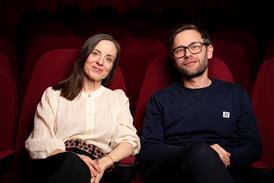At the inaugural film-maker retreat at the Palm Springs International Film Festival, Jeremy Kay talks to the film-making teams behind two documentaries. Tchavdar Georgiev and Amanda Pope’s who made The Desert Of Forbidden Art and Michael King and Joyce Mandell whose project is The Rescuers.
Tchavdar Georgiev and Amanda Pope’s The Desert Of Forbidden Art recounts how painter Igor Savitsky established a priceless collection of Russian and Central Asian art at a museum in Uzbekistan. Director Michael King and executive producer andphilanthropist Joyce Mandell are behind The Rescuers, the story of diplomats who saved Jews during World War II.Tchavdar Georgiev and Amanda Pope’s The Desert Of Forbidden Art recounts how painter Igor Savitskyestablished a priceless
What was the retreat like?
Michael King: “It was fantastic that 20 international film-makers could come together and share their recent works and discuss their experiences. It gave me a better understanding as a film-maker to hear different stories, see different films.”
Amanda Pope: “We saw trailers of some films. When you go to a festival you meet people in the hospitality suite but you don’t get the same opportunity to bond as we did in the retreat. We formed a little pod for the rest of the festival and we’re all going to each other’s films.”
Michael how did The Rescuers come about?
MK: “I’d just finished a film called Rapping With Shakespeare and was thinking about my next film and Joyce [whom King has know for years] told me about this exhibit on Ellis Island, New York, about these diplomats who risked their lives saving thousands of people during the Holocaust.”
Joyce Mandell: “We wanted to inject more life into the story, so we thought it would be a good idea to make a documentary. These diplomats risked their lives 70 years ago but where are the diplomats doing this today for Rwanda and Darfur? In our film the UK historian Martin Gilbert asks this question. It’s a very timely subject.”
Michael, you started researching The Rescuers in June 2008 and began filming in November 2008 when the financial crisis struck. How did that impact on your film?
MK: “The financial crisis meant that the money for the film that was coming through from Joyce’s family foundation was in jeopardy, but the foundation stuck with us. The crews we worked with in every country shot for less and we got good deals on equipment. Some of the embassies helped and in Venice they waived filming permits, for example.”
Did you face similar obstacles on The Desert Of Forbidden Art?
TG: “We had many angels but our grants from George Soros’ Open Society and USC and other sources maybe covered two-thirds of the cost of the production, so you were dealing a lot with your own sweat equity. For us the challenge was getting into Uzbekistan. This is a very remote collection. I speak Russian and that helped.”
When Savitsky began to assemble the collection of 40,000 paintings in the 1960s he underwent considerable personal risk and had to deal with corrupt bureaucrats and nomadic tribesmen. What is the state of the collection today?
AP: “This collection is in danger now because Uzbekistan is a muslim country. Many of the painters were Russians who came to this region and the Uzbeks are not quite sure how they feel about their former colonists so this has made them somewhat reluctant to support the collection. The troubles is art sharks will come in and cherry pick some of the paintings, some of which are worth millions of dollars.”






















No comments yet